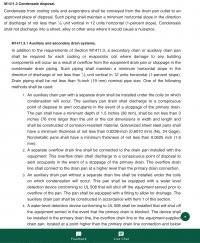north star
Sawhorse
- Joined
- Oct 19, 2009
- Messages
- 4,596
@ @ ~ @ @
I have an application where a homeowner has an
HVAC package unit in their attic........They currently
have the condensation drain pan, primary drain
line directed in to the sanitary sewer drain piping
nearby............No "Overflow Shut-Off Sensor"
is installed in the drain pan.
Q1): Is the Condensation Drain Pan, primary drain
line " required " to be connected to the sanitary
sewer piping, or can it be installed similar to a Water
Heater, Drain Pan piping that gravity flows to the
exterior of the bldg. ?..........Please provide the
applicable Code Sections and or Commentary.
The applicable Codes for reference are the 2012,
2015 & 2018 Residential Codes.
Q2): Can a secondary drain line also be installed
to the exterior of the bldg. ?
FWIW, ...the homeowner is wanting to remove the
sanitary sewer connection, cap the piping and
direct all condensation piping to the exterior.
Your input is GREATLY appreciated !..........Thank you !
@ @ ~ @ @
I have an application where a homeowner has an
HVAC package unit in their attic........They currently
have the condensation drain pan, primary drain
line directed in to the sanitary sewer drain piping
nearby............No "Overflow Shut-Off Sensor"
is installed in the drain pan.
Q1): Is the Condensation Drain Pan, primary drain
line " required " to be connected to the sanitary
sewer piping, or can it be installed similar to a Water
Heater, Drain Pan piping that gravity flows to the
exterior of the bldg. ?..........Please provide the
applicable Code Sections and or Commentary.
The applicable Codes for reference are the 2012,
2015 & 2018 Residential Codes.
Q2): Can a secondary drain line also be installed
to the exterior of the bldg. ?
FWIW, ...the homeowner is wanting to remove the
sanitary sewer connection, cap the piping and
direct all condensation piping to the exterior.
Your input is GREATLY appreciated !..........Thank you !
@ @ ~ @ @

